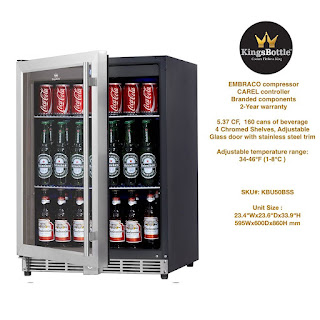Steak Ager Fridge: Everything You Need to Know
Ever wonder why steak on a big rotisserie can taste so much better and more tender than the steaks you take off your backyard grill? Or why do they cost so much more?
Dry aging is the process by which large cuts of
beef are aged for several weeks to several months before being trimmed and cut
into fillets. It is a process that not only helps the steak develop flavor, but
also makes it much more tender than it would be completely fresh.
Dry-aged meat, or
even dry-aged beef, has been the steak trend for several years. At the center
of attention are buttery nutty flavors and high-quality processing. The
maturation process requires quality criteria, from the texture of the meat to
the technique of the process. You can even age your own meat at home. For example,
with a dry-aging refrigerator.
When there were still
no stable ventilation and cooling systems, butchers overpowered an enemy in
dry-ripening: rotten bone marrow. That is why the decision was made with the
advent of vacuum technology for this method, which at that time was safer and
cheaper, since in the end what is aspirated is also lost in terms of weight. If
you like to Buy Steak Ager Fridge in Australia, there are many good
online stores that help you in buying it at affordable prices.
Thanks to technical
progress, the Dry Aged process has become safer and easier. And it takes less
space. Although there are some butchers who specialize exclusively in jerky
with well-equipped and spacious ripening chambers, most butchers and
restaurants, such as steakhouses, are now equipped with a dry-aging refrigerator. In it, the whole veal halves have space and in the closed
cupboard, the climate is perfectly controllable. Therefore, there are no
unpleasant surprises with less energy expenditure than the maturity chamber
requires.
What is Wet Aging?
The least expensive
alternative to dry aging is called wet aging. The meat is sent from the packing
plants to the butcher shops in vacuum packing. Butchers can store this packaged
meat in their refrigerators and let it age. Since meat is packed in its own
juices, enzymes break down connective tissues and make it more tender. However,
because there will be no fluid loss, the flavor concentration you get from dry
aging will not occur.
You may be tempted to
age your beef at home. You can take a vacuum-packed primary cut (from which
market cuts are taken) from the butcher and put it in the fridge for two weeks
in the hopes of producing a really tender piece of meat. However, aging must
take place at precise temperatures and humidity under controlled circumstances.
The average family refrigerator just doesn't have what it takes to properly age
meat. It is very easy to get a good colony of bacteria in that meat for a
couple of weeks it takes to mature a piece of meat.
Why dry-aged beef
tastes better?
All fresh meat is
aged for at least a few days and up to several weeks to allow the enzymes
naturally present in the meat to break down the muscle tissue, improving
texture and flavor. These days, most of the beef is aged in shrink plastic, a
process known as wet aging.
Dry-aged beef, on the
other hand, is exposed to air so that dehydration can further concentrate the
flavor of the meat. However, it is a more expensive process than wet aging
because meat loses weight due to dehydration and must also be trimmed from its
completely dry exterior.
We dry-dry a
previously wet-aged, boneless beef rib roast from our local market in one of
our test kitchen refrigerators for three days. We had another roast of ribs
from the same steer that we left in its plastic wrap to continue aging for the
same amount of time. After roasting them, we tested them side by side.
The dry-aged roast
was more succulent and had a milder but meatier flavor than the wet-aged roast,
which had a watery taste in comparison. We then dry-aged another roast for
seven days and were blown away by the taste. Despite the 20% loss of its
original weight, we are convinced that for a truly special occasion, such as a
Christmas or New Years’ dinner, dry-cured beef is worth the time and expense.
How to dry-age beef
at home
- Buy
a boneless prime rib or roast tenderloin or a choice from the best meat
source in your area.
- unwrap
the meat, rinse well, and pat dry with paper towels. Do not trim. Loosely
wrap the roast in a triple layer of cheesecloth and place it on a wire
rack on a rimmed baking sheet or another tray.
- Refrigerate
three to seven days; the older the meat ages, the tastier it becomes.
After the first day, carefully unwrap and then rewrap with the same gauze
to prevent the fabric fibers from sticking to the meat.
- When
you are ready to grill, unwrap the meat and, using a sharp knife, shave
and discard the tough, dry outer layer of the meat. Also, remove dry areas
of fat, but leave as much good fat as possible. Grill whole or cut into steaks.
A food safety note
Home refrigerators
are not as consistent or as cold as commercial meat cabinets. Before aging meat
at home, obtain a refrigerator thermometer, and make sure your refrigerator is
below 40 °F. Cook or freeze meat within seven days of starting the dry-aging
process.
Let's Wrap Up:
One of the best dry
aging refrigerators has a noble design, the Kingsbottle. The stainless steel
optic is an eye-catcher in any butcher or steakhouse. Through the door,
customers can marvel at the product right into the ripening process and look
forward to a juicy, dry-aged steak. So what are you waiting for! Buy Steak Ager Fridge in Australia, and enjoy the relishing taste of steak.




Comments
Post a Comment